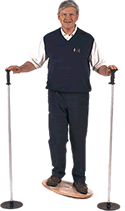Your Cart is Empty
⭐ Trusted by top athletes from LIV Golf, CFL, NFL & Alpine Canada ⭐
⭐ Trusted by top athletes from LIV Golf, CFL, NFL & Alpine Canada ⭐
Shop
Products
Balance Problems Found Treatable By Training
January 01, 2002 3 min read

From Tribune News Service (USA),
Reprinted in China Post (Taiwan),
December 1992

So many people who slowly lose the ability to maintain their balance can reverse much of that decline through a program of exercise and balance training, a study has found.
In general, healthy people as old as 90, exercise and balance training can reduce the tendency to fall by 50 percent, according to the study.
Approximately one-third of older people experience a fall each year, with one in 20 falls resulting in serious injury. Each year, about 250,000 Americans fracture their hip, resulting in long-term disability, pain, and in 10 percent of hip fractures, death.
"Falls and impaired mobility are critical problems for older people," said Dr. Leslie Wolfson, Chairman of the Department of Neurology at the University of Connecticut Health Center in Farmington.
Wolfson's study, supported by the National Institute on Aging in Bethesda, MD., is one of eight around the country aimed at improving gait and balance in the elderly, said Dr. Evan Hadley, Associate Director for Geriatrics at the Institute.
"We think it's a very promising line of research, and could point the way to techniques to keep people independent and avoid the need for nursing homes", Hadley said.
Wolfson's three-year study on reducing the risk of falling, only recently completed and not yet published, grew out of an earlier study published in the November issue of the journal Neurology.
The Neurology study compared 34 people whose average age was 34 with 234 people whose average age was 76. Using a special electronic device called a computerized dynamic posturgraphy platform, Wolfson placed people in a closed space where the floor they stood on would move and rotate up and down, forward and back. Sometimes the walls would move in sync with them, and other times the walls would remain motionless tricking their eyes and making it more difficult to stay upright.
"It would be like getting on a bus and having it stop suddenly," Wolfson said.
The study found that elderly people kept their balance almost as well as younger people when the platform remained relatively steady, but were less steady when the platform began swaying in various directions.
But people aged 80 and over did only slightly worse than people aged 70, suggesting that age-related loss of balance is negligible, Wolfson concluded.
Older people got better at maintaining their balance the longer they were tested, suggesting that they could benefit from training, he said.
That insight led Wolfson to conduct his second study to see how exercise and balance training would improve elderly people's balance.
In the second study, 108 people aged 70 and older, all of them in relatively good health were trained for three months with weights and exercises on padded surfaces. Trained coaches stood nearby to catch them in case they fell.
Wolfson found that after three months of training, the people almost lost their balance only half as often as they did before the study.
The take-home message for seniors: their sense of balance can be improved.
The first thing you look for is medically treatable diseases, Wolfson said. For instance, treating Parkinson's disease can improve balance. And many medications can worsen a person's sense of balance if a doctor doesn't adjust the dosage, Wolfson added.
Strengthening exercises can be done under the direction of a physical therapist or in a senior exercise program, said Wolfson. He recommended walking and stair-climbing for seniors trying to improve their sense of balance.
Subscribe
Sign up to get the latest on sales, new releases and more …

